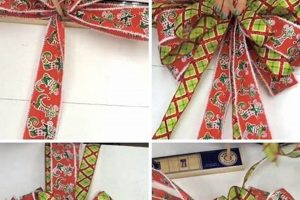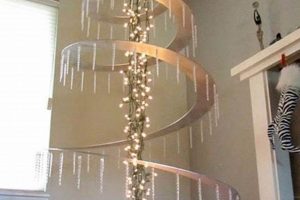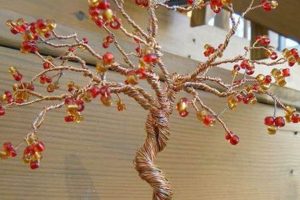Constructed Christmas trees using a conical base are a popular holiday craft. These decorative items are typically made by adhering various materials, such as fabric scraps, ribbons, pinecones, or artificial foliage, to a cone-shaped form. The resulting creations serve as festive decorations for homes and offices during the Christmas season.
The appeal of crafting miniature Christmas trees stems from their customizable nature and cost-effectiveness. They provide a creative outlet, allowing individuals to personalize their holiday dcor to match specific themes or color schemes. Furthermore, these projects often repurpose existing materials, promoting sustainable practices and reducing waste. The tradition of creating handcrafted Christmas decorations extends back centuries, with cone-shaped trees representing a modern adaptation of earlier decorative forms.
The following sections will detail methods for creating these trees, exploring diverse material choices, construction techniques, and design considerations for crafting unique holiday accents.
Crafting Conical Christmas Trees
The creation of decorative conical Christmas trees benefits from careful planning and execution. Adhering to the following tips will enhance the quality and longevity of the finished product.
Tip 1: Select a Sturdy Base: Opt for a cone constructed of cardboard, foam, or a similar rigid material. This provides a stable foundation for embellishments, preventing collapse or distortion. Consider the size and proportions of the cone relative to the intended display area.
Tip 2: Employ Appropriate Adhesives: The choice of adhesive is crucial for securely attaching materials. Hot glue is suitable for many applications, but consider alternatives like craft glue or spray adhesive for delicate fabrics or paper elements. Ensure the adhesive is compatible with both the cone and the embellishment material.
Tip 3: Plan the Design Prior to Application: Sketching a design or laying out materials before permanently affixing them allows for adjustments and ensures a cohesive aesthetic. This step minimizes errors and wasted materials.
Tip 4: Prioritize Even Distribution of Materials: Distribute embellishments uniformly across the cone’s surface to maintain balance and prevent visual imbalance. Overcrowding one area can detract from the overall appearance.
Tip 5: Incorporate Textural Variety: Introduce diverse textures, such as smooth ribbons alongside rough pinecones, to add visual interest and depth. The juxtaposition of contrasting materials enhances the tree’s aesthetic appeal.
Tip 6: Secure Loose Ends and Protrusions: After completing the embellishment process, carefully inspect the tree for any loose ends, protruding wires, or unsecured elements. Address these issues promptly to prevent unraveling or potential hazards.
Tip 7: Allow Adequate Drying Time: Ensure all adhesives have fully cured before handling or displaying the tree. Premature handling can result in dislodged materials and compromise the overall structure.
By implementing these strategies, the creation of durable and visually appealing conical Christmas trees becomes more achievable. Careful attention to detail and material selection are key to a successful outcome.
The subsequent section will delve into various design inspirations and advanced techniques for customizing these handcrafted holiday decorations.
1. Base Material
The selection of an appropriate base material is paramount in the construction of stable and aesthetically pleasing conical Christmas trees. The base directly influences the tree’s structural integrity, overall shape, and suitability for various decorative embellishments. The material must provide sufficient support while also being receptive to adhesives and other attachment methods.
- Cardboard Cones:
Cardboard presents a cost-effective and readily available option. It is easily cut and shaped, allowing for customization of the cone’s size and angle. However, cardboard may lack the rigidity required for heavier embellishments and can be susceptible to moisture damage. Real-world applications include using recycled cardboard boxes to create miniature trees for office decorations. The implication is that while accessible, careful consideration must be given to the weight and type of decorative materials used.
- Foam Cones:
Foam cones offer a lightweight yet sturdy alternative. They accept pins and adhesives readily, simplifying the attachment process for various materials. Foam is also resistant to moisture, making it suitable for environments with varying humidity levels. These are commonly found in craft stores and are used for creating trees adorned with delicate fabrics or ribbons. The drawback is that foam can be more expensive than cardboard, and some types may release fumes when used with certain adhesives.
- Paper Mache Cones:
Paper mache allows for the creation of custom-shaped and sized cones. It provides a relatively strong and lightweight base that can be painted or otherwise decorated before embellishments are applied. This method is often employed in educational settings to teach crafting techniques. A disadvantage is the time required for the paper mache to dry completely, and its susceptibility to damage if not properly sealed or coated.
- Wire Mesh Frames:
Wire mesh provides a durable and adaptable base for more unconventional tree designs. The open structure allows for the easy attachment of materials like greenery, lights, or ornaments using wire or zip ties. This approach is suitable for creating larger, outdoor-oriented conical trees. The increased durability comes with a need for specialized tools and techniques to shape the wire and secure the embellishments effectively.
The ultimate choice of base material depends upon the desired aesthetic, the intended use of the conical Christmas tree, and the budget constraints. Each material offers distinct advantages and disadvantages that must be carefully evaluated to ensure a structurally sound and visually appealing final product. Ignoring these material properties may lead to structural failure or a final product that doesn’t align with the initial design. For example, a heavy, ornament-laden tree on a flimsy cardboard base is likely to collapse, emphasizing the crucial link between base material selection and the success of the crafting project.
2. Adhesive Strength
Adhesive strength plays a critical role in the construction and longevity of handcrafted conical Christmas trees. The effectiveness of the bond between the base material and the decorative embellishments directly impacts the durability and visual appeal of the final product.
- Material Compatibility
Different materials require specific adhesives to achieve optimal bonding. For example, porous materials like fabric or paper mache often bond well with craft glue or spray adhesive, while non-porous materials like glass beads or plastic ornaments may necessitate the use of hot glue or epoxy. Using an incompatible adhesive can result in weak bonds, causing decorations to detach over time. Consider a tree decorated with sequins: if the adhesive chosen is not suited for the plastic backing of the sequins, they will readily fall off, diminishing the overall effect.
- Bonding Surface Area
The area of contact between the adhesive and the materials being bonded influences the strength of the connection. Larger surface areas generally result in stronger bonds. For instance, applying a continuous bead of glue along the entire length of a ribbon offers greater adhesion than simply dabbing glue at intervals. In practical terms, a wide ribbon adhered with continuous glue will remain securely attached, while a narrow ribbon sparsely glued will likely detach. This is especially important for supporting the weight of heavier ornaments.
- Curing Time and Environmental Factors
Most adhesives require a specific curing time to achieve their maximum bond strength. Environmental factors such as temperature and humidity can also impact the curing process. For example, hot glue typically cures rapidly in dry conditions, while some craft glues may require several hours to fully set. In humid environments, some adhesives may take longer to cure or may not achieve their full strength. Ignoring these factors can lead to premature failure of the adhesive bond. A tree left in a damp basement might see its decorations loosen significantly faster than one stored in a climate-controlled environment.
- Adhesive Application Technique
The method of adhesive application also contributes to the strength of the bond. Applying an even, consistent layer of adhesive ensures uniform contact between the materials. Over-application can lead to messy results and weakened bonds due to excessive seepage, while under-application can result in insufficient adhesion. Using the correct applicator (e.g., a fine-tipped nozzle for detail work, a glue gun for larger areas) ensures optimal coverage and bond strength. For example, dabbing small quantities of glue over a larger area may result in a weak tree.
In summary, selecting the appropriate adhesive, preparing the bonding surfaces, understanding curing times, and employing proper application techniques are all essential for ensuring the durability and aesthetic appeal of conical Christmas trees. Failure to adequately address these considerations will inevitably lead to decorative elements detaching, compromising the overall integrity of the handcrafted creation.
3. Design Cohesion
Design cohesion in the context of handcrafted conical Christmas trees refers to the unified and harmonious arrangement of decorative elements, ensuring a visually pleasing and aesthetically consistent final product. This principle dictates that all components of the tree, including color palettes, materials, and thematic elements, work together to create a sense of unity.
- Color Palette Consistency
A consistent color palette is fundamental to design cohesion. The selected colors should complement one another, creating a visually balanced and harmonious effect. For instance, a tree utilizing various shades of gold, silver, and white will exude an elegant and refined aesthetic. Conversely, a tree incorporating clashing or disparate colors may appear disorganized and visually jarring. An example of color palette consistency might involve using metallic spray paint and varying shades of the same hue for the embellishments.
- Thematic Unity
Establishing a clear theme provides a framework for selecting and arranging decorative elements. A nautical-themed tree, for example, might incorporate seashells, miniature sailboats, and blue and white ribbons, creating a cohesive and thematic representation. Without a unifying theme, the decorative elements may appear random and disconnected. Conversely, a tree with a “winter wonderland” theme could consist of faux snow, icicle ornaments, and silver garland.
- Material Harmony
The selection of materials should complement the overall design aesthetic. Combining contrasting materials, such as rustic burlap with delicate lace, can create visual interest and depth, but should be done judiciously to maintain cohesion. Overuse of dissimilar materials can result in a chaotic and disjointed appearance. A tree using primarily natural materials, such as pinecones, dried flowers, and wooden beads, will project a more organic and earthy aesthetic than one adorned with plastic ornaments and glitter.
- Scale and Proportion
Maintaining appropriate scale and proportion among the decorative elements is crucial for visual harmony. Overly large or disproportionate elements can overwhelm the tree and disrupt its balance. Conversely, excessively small elements may become lost or insignificant. A balanced approach ensures that all components contribute harmoniously to the overall design. Imagine a small cone tree with oversized baubles which looks unbalanced.
In conclusion, design cohesion is an indispensable element in the creation of visually appealing and aesthetically unified conical Christmas trees. By carefully considering color palette consistency, thematic unity, material harmony, and scale/proportion, individuals can craft decorative pieces that are both aesthetically pleasing and reflective of their personal style. Overlooking these facets can lead to a final product lacking visual appeal and unity.
4. Material Distribution
Material distribution, in the context of crafting conical Christmas trees, denotes the strategic placement of decorative elements across the cone’s surface. This distribution significantly influences the overall aesthetic appeal and visual balance of the finished piece. Uneven or haphazard distribution can result in a lopsided or unbalanced appearance, detracting from the intended festive design. The even dispersal ensures that no single area overwhelms the visual field, allowing each element to contribute effectively to the overall aesthetic.
For instance, consider a miniature Christmas tree decorated with artificial berries and pinecones. If the berries are clustered predominantly at the base of the cone, the top portion may appear sparse and unfinished. Conversely, a more balanced distribution of berries throughout the tree’s height creates a visually complete and harmonious effect. Similarly, when applying glitter or flocking, an even coating ensures a uniform, snow-like appearance, while uneven application results in a patchy and unprofessional finish. Careful arrangement, particularly with larger or more prominent elements, prevents any single area from appearing overloaded or neglected. Its not about just sticking things onto the cone; its about arranging them in a way that makes visual sense.
Effective material distribution requires planning and attention to detail. Before permanently affixing any embellishments, it is beneficial to arrange them loosely on the cone to assess their placement and adjust as needed. This preparatory step allows for a more informed and deliberate distribution strategy. The practical significance lies in its impact on the final product’s visual integrity. Well-distributed materials elevate a simple craft project into a polished, professional-looking decoration, underscoring the importance of this often-overlooked component of crafting conical Christmas trees. Improper distribution leads to unbalance, unorganized appearance and therefore less pleasing visual. Material Distribution is not merely a step, it’s a component of successful conical Christmas tree creation.
5. Textural Variety
Textural variety is a critical design element in the creation of visually engaging handcrafted conical Christmas trees. The strategic incorporation of diverse textures generates visual interest and depth, elevating the aesthetic impact of the finished product. Monotonous surfaces, lacking textural contrast, often appear flat and uninspired. Conversely, a well-considered mix of textures adds complexity and sophistication to the design.
The cause-and-effect relationship is direct: employing different textures creates visual dynamism. For instance, combining the rough, organic texture of burlap with the smooth sheen of satin ribbon offers a tactile and visual contrast that captures the eye. Similarly, juxtaposing the prickly surface of preserved moss with the delicate smoothness of glass beads introduces a compelling interplay of sensations. The absence of such textural variation frequently results in a visually unremarkable decoration. The practical significance of understanding this principle lies in the ability to transform a simple craft project into a visually stimulating and professionally finished product. Texture is crucial for the visual appeal that invites touch.
To illustrate further, a conical Christmas tree adorned solely with felt pieces, despite variations in color, may lack the visual interest of a tree incorporating felt, wooden beads, and metallic embellishments. The latter combination introduces tactile and visual diversity, enhancing the overall design. Incorporating textural considerations poses challenges. Balancing the different textures is key. Textural clash can diminish an otherwise well-executed design. Ultimately, the skillful integration of textural variety is essential for maximizing the visual impact and tactile appeal of constructed conical Christmas trees.
6. Securement
Securement represents a fundamental element in the successful creation and longevity of handcrafted conical Christmas trees. The term encompasses the methods and materials employed to ensure that all decorative elements are firmly affixed to the base structure, preventing detachment and maintaining the aesthetic integrity of the finished product over time.
- Adhesive Application and Compatibility
The selection and application of adhesives directly impact securement. Different materials require specific adhesives to ensure adequate bonding. For instance, hot glue may be suitable for attaching heavier ornaments to a cardboard base, while craft glue is often sufficient for lighter elements like fabric scraps. Incompatibility between the adhesive and the material can result in weak bonds and subsequent detachment. An example of poor securement is the use of craft glue on glass ornaments; over time, the ornaments will likely detach due to the adhesive’s inability to create a strong bond with the non-porous surface. Implication is that careful consideration is required in terms of materials vs adhesives and weight bearing potential.
- Mechanical Fasteners
Mechanical fasteners, such as pins, wires, or staples, provide a supplementary means of securement, particularly for larger or heavier decorative elements. These fasteners offer a physical connection between the embellishments and the cone base, enhancing the overall stability of the design. A real-world application involves using floral pins to secure fabric folds or ribbon swags to a foam cone. This method is especially useful when adhesive alone is insufficient to support the weight or tension of the materials. A downside might be appearance, where they must remain hidden.
- Finishing Techniques
Finishing techniques, such as sealing or coating, can further enhance securement by protecting the adhesive bonds from environmental factors like moisture or temperature fluctuations. These techniques create a barrier that prevents the adhesive from degrading or becoming brittle over time. An example of this would be applying a clear sealant over a tree decorated with glitter or sequins to prevent shedding. Coating the structure to prevent shedding of embellishments increases securement longevity.
- Weight Distribution and Balance
Even weight distribution plays a crucial role in maintaining the structural integrity of the tree. Overloading one side or section of the cone can create stress on the adhesive bonds, leading to detachment and imbalance. Strategic placement of heavier elements near the base of the cone can help to stabilize the structure and prevent it from toppling. Distributing weight evenly is crucial for avoiding stress on points within the conical Christmas tree and it’s securement strategy.
Effective securement practices are essential for ensuring that handcrafted conical Christmas trees remain visually appealing and structurally sound over extended periods. By carefully considering adhesive compatibility, employing mechanical fasteners when necessary, utilizing appropriate finishing techniques, and maintaining even weight distribution, individuals can create durable and aesthetically pleasing holiday decorations.
Frequently Asked Questions
The following section addresses common inquiries and clarifies key aspects related to the construction and maintenance of handcrafted conical Christmas trees. These answers aim to provide concise and informative guidance for achieving optimal results.
Question 1: What is the optimal adhesive for securing heavy ornaments to a cardboard cone?
Hot glue guns, utilizing high-temperature adhesive sticks, provide a rapid and robust bond suitable for securing heavier decorative elements to a cardboard base. Proper ventilation is advised during application to mitigate inhalation of fumes. The structural integrity depends on adhesive.
Question 2: How can the shedding of glitter from decorated trees be minimized?
Application of a clear acrylic sealant, designed for craft projects, can effectively encapsulate glitter particles, thereby reducing shedding. Several light coats are preferable to a single heavy application to prevent clumping or discoloration.
Question 3: Which base material is most resistant to moisture damage?
Closed-cell foam cones offer superior resistance to moisture absorption compared to cardboard or paper mache. This characteristic makes them suitable for environments with high humidity or potential exposure to water.
Question 4: How can a balanced distribution of materials be achieved on an asymmetrical cone?
Pre-planning the design through sketching or mock-ups allows for strategic placement of heavier or more visually prominent elements to compensate for the cone’s asymmetry. Incremental adjustments are recommended during the application process.
Question 5: What are the recommended storage conditions for handcrafted conical Christmas trees?
Storage in a cool, dry environment, away from direct sunlight, is advised to prevent material degradation and adhesive weakening. Wrapping the tree in acid-free tissue paper can provide additional protection against dust and abrasion.
Question 6: How can the stability of a tall, narrow conical Christmas tree be enhanced?
Attaching a weighted base, such as a circular piece of wood or metal, can lower the center of gravity and improve stability. Ensure the base is securely fastened to the cone to prevent accidental separation.
These FAQs highlight the crucial aspects of material selection, securement techniques, and preventative measures for ensuring the longevity and visual appeal of these handcrafted decorations.
The next section will explore advanced decorative techniques for personalizing conical Christmas tree designs.
Concluding Remarks on DIY Cone Christmas Trees
The preceding exploration has illuminated the multifaceted nature of constructing conical Christmas trees. From selecting appropriate base materials and adhesives to implementing effective distribution and securement strategies, each stage significantly contributes to the final product’s aesthetic and structural integrity. Design cohesion and textural variety have been demonstrated as vital for achieving visually engaging and harmonious creations.
The diligent application of these principles empowers individuals to craft unique and personalized holiday decorations. Further experimentation with materials and techniques will undoubtedly expand the possibilities within this craft, fostering continued innovation in decorative design for festive occasions. The enduring appeal of these projects lies in their adaptability and potential for creative expression.







